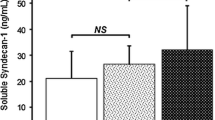Abstract
In Crohn's disease, the activity of the disease is sometimes difficult to evaluate and the evolution of the disease is difficult to predict. The soluble interleukin-2 receptor serum level has been reported to correlate with clinical activity of the disease and with mucosal immune activation. We compared serum soluble interleukin-2 receptor to classical inflammatory markers and other immune parameters in the assessment of clinical disease activity and prediction of relapse in patients with Crohn's disease. Soluble interleukin-2 receptor serum levels correlated well with the Crohn's disease activity index, and multivariate analysis showed that this correlation was independent of the other inflammatory and immune markers. The correlation was not greater, however, than that between some inflammatory markers, such as ESR, and Crohn's disease activity index. Longitudinal follow-up showed that a high soluble interleukin-2 receptor serum level was highly predictive of relapse. Multivariate analysis showed that the soluble interleukin-2 recepteur serum level was complementary to other inflammatory, and clinical markers in the prediction of relapse of disease. We conclude that soluble interleukin-2 receptor is of use in monitoring Crohn's disease, particularly in prediction of relapse.
Similar content being viewed by others
References
Strober W, James SP: The immunologic basis of inflammatory bowel disease. J Clin Immunol 6:415–432, 1986
Campbell, CA, Walker-Smith JA, Hindocha P, et al: Acute phase proteins in chronic inflammatory bowel disease in childhood. J Pediatr Gastroenterol Nutr 1:193–200, 1982
Vesparget H, Biemond I, Waterman I: Biochemical parameters as activity index in Crohn's disease. International congress of Gastroenterology, Lisbon, 1984, p. 298, (abstract)
Williams AJK, Symons JA, Watchet K, Duff GW: Soluble interleukin-2 receptor and disease activity in Crohn's disease. J Autoimmun 5:251–259, 1992
Andre C, Descos I, Vignal J, Gillon J: C-reactive protein as predictor of relapse in asymptomatic patients with Crohn's disease. Scott Med J 28:26–29, 1983
Brignola C, Campieri M, Bazzocchi G, Farruggia P, Tragnone A, Lanfranchi GA: A laboratory index for predicting relapse in asymptomatic patients with Crohn's disease. Gastroenterology 91:1490–1494, 1986
Brignola C, Iannone P, Belloli C, De Simone G, Bassein L, Gionchetti P, Belluzzi A, Campieri M, Barbara L: Prediction of relapse in patients with crohn's disease in remission: a simplified index using laboratory tests, enhanced by clinical characteristics. Eur J Gastroenterol Hepatol 6:955–961, 1994
Matsuura T, West GA, Klein JS, Ferraris L, Fiocchi C: Soluble interleukin 2 and CD8 and CD4, receptors in inflammatory bowel disease. Gastroenterology 102:2006–2014, 1992
Mahida YR, Gallagher A, Kurlak L, Hawkey CJ: Plasma and tissue interleukin-2 receptor levels in inflammatory bowel disease. Clin Exp Immunol 82:75–80, 1990
Brynskov J, Tvede N: Plasma interleukin-2 and a soluble/shed interleukin-2 receptor in serum of patients with Crohn's disease. Effect of cyclosporin. Gut 31:795–799, 1990
Mueller C, Knoflach P, Zielinski CC: T-cell activation in Crohn's disease. Increased levels of soluble interleukin-2 receptor in serum and in supernatants of stimulated peripheral blood mononuclear cells. Gastroenterology 98:639–646, 1990
Crabtree JE, Juby LD, Heatley RV, Lobo AJ, Bullimore DW, Axon ATR: Soluble interleukin-2 receptor in Crohn's disease: relation of serum concentrations to disease activity. Gut 31:1033–1036, 1990
Readler A, Fraenkel S, Klose G, Seyfarth K, Thiele HG: Involvement of the immune system in the pathogenesis of Crohn's disease. Expression of the T9 antigen on peripheral immunocytes correlates with the severity of the disease. Gastroenterology 88:978–983, 1985
Rutgeerts P, Geboes K, Vantrappen G, Beyls J, Kerremans R, Hiele M: Predictability of the postoperative course of Crohn's disease. Gastroenterology 99:956–963, 1990
Modigliani R, Mary JY, Simon JF, et al: Clinical biological and endoscopic picture of attacks of Crohn's disease; evolution on prednisolone. Gastroenterology 98:811–818, 1990
Cellier C, Sahmoud T, Froguel E, et al: Correlations between clinical activity, endoscopic severity, and biological parameters in colonic or ileocolonic Crohn's disease. A prospective multicentre study of 121 cases. Gut 35:231–235, 1994
Sahmoud T, Modigliani R, Gendre JP, Mary JY: Predicting relapse in quiescent cronh's disease patients: index construction and cross-validation. Gastroenterology 106:A1048, 1994 (abstract)
Author information
Authors and Affiliations
Additional information
Supported by a grant Smith Kline Beecham Biologicals from the National Funds for Scientific Research Belgium (to E.L.).
Rights and permissions
About this article
Cite this article
Louis, E., Belaiche, J., Van Kemseke, C. et al. Soluble interleukin-2 receptor in Crohn's disease. Digest Dis Sci 40, 1750–1756 (1995). https://doi.org/10.1007/BF02212697
Received:
Revised:
Accepted:
Issue Date:
DOI: https://doi.org/10.1007/BF02212697




